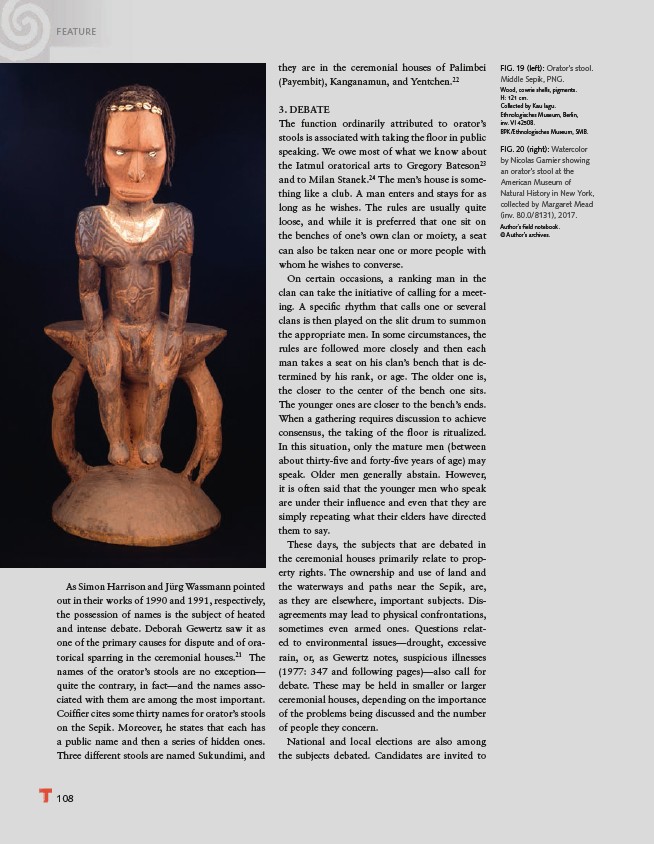
FEATURE
108
they are in the ceremonial houses of Palimbei
(Payembit), Kanganamun, and Yentchen.22
3. DEBATE
The function ordinarily attributed to orator’s
stools is associated with taking the fl oor in public
speaking. We owe most of what we know about
the Iatmul oratorical arts to Gregory Bateson23
and to Milan Stanek.24 The men’s house is something
like a club. A man enters and stays for as
long as he wishes. The rules are usually quite
loose, and while it is preferred that one sit on
the benches of one’s own clan or moiety, a seat
can also be taken near one or more people with
whom he wishes to converse.
On certain occasions, a ranking man in the
clan can take the initiative of calling for a meeting.
A specifi c rhythm that calls one or several
clans is then played on the slit drum to summon
the appropriate men. In some circumstances, the
rules are followed more closely and then each
man takes a seat on his clan’s bench that is determined
by his rank, or age. The older one is,
the closer to the center of the bench one sits.
The younger ones are closer to the bench’s ends.
When a gathering requires discussion to achieve
consensus, the taking of the fl oor is ritualized.
In this situation, only the mature men (between
about thirty-fi ve and forty-fi ve years of age) may
speak. Older men generally abstain. However,
it is often said that the younger men who speak
are under their infl uence and even that they are
simply repeating what their elders have directed
them to say.
These days, the subjects that are debated in
the ceremonial houses primarily relate to property
rights. The ownership and use of land and
the waterways and paths near the Sepik, are,
as they are elsewhere, important subjects. Disagreements
may lead to physical confrontations,
sometimes even armed ones. Questions related
to environmental issues—drought, excessive
rain, or, as Gewertz notes, suspicious illnesses
(1977: 347 and following pages)—also call for
debate. These may be held in smaller or larger
ceremonial houses, depending on the importance
of the problems being discussed and the number
of people they concern.
National and local elections are also among
the subjects debated. Candidates are invited to
FIG. 19 (left): Orator’s stool.
Middle Sepik, PNG.
Wood, cowrie shells, pigments.
H: 121 cm.
Collected by Kau Iagu.
Ethnologisches Museum, Berlin,
inv. VI 42508.
BPK/Ethnologisches Museum, SMB.
FIG. 20 (right): Watercolor
by Nicolas Garnier showing
an orator’s stool at the
American Museum of
Natural History in New York,
collected by Margaret Mead
(inv. 80.0/8131), 2017.
Author’s fi eld notebook.
© Author’s archives.
As Simon Harrison and Jürg Wassmann pointed
out in their works of 1990 and 1991, respectively,
the possession of names is the subject of heated
and intense debate. Deborah Gewertz saw it as
one of the primary causes for dispute and of oratorical
sparring in the ceremonial houses.21 The
names of the orator’s stools are no exception—
quite the contrary, in fact—and the names associated
with them are among the most important.
Coiffi er cites some thirty names for orator’s stools
on the Sepik. Moreover, he states that each has
a public name and then a series of hidden ones.
Three different stools are named Sukundimi, and